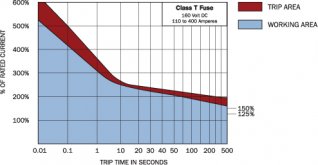topperharley
New Member
- Joined
- Feb 10, 2021
- Messages
- 33
Hello all,
I am looking to upgrade my RV electrical with a DiY LiFePo4 280AH battery and a victron 3000 charger/inverter, but have some questions I'm hoping someone can clear up for me. Here is a diagram similar to what I'll be doing, but with some differences; I won't be using a built in surge, and I don't have a built in generator, so my shore power will be going directly to the inverter. I'm also using the victron bluetooth shunt instead of the BMV-712 monitor. Currently don't have solar, but will most likely be adding a solar charger to the system at a later date.
I ordered the 280AH EVE battery from Will's links (hopefully to be here within the month) and purchased a DALY 250A BMS for it. So couple questions regarding this: 1. if the cells all come at the same voltage, how important is it to top balance these cells? will the BMS balance them over time, if off slightly? 2. Does the DALY BMS need to be programmed to the application I'm using it for, and if so how do I communicate with it? Its not the smart version, nor does it have uart. I ordered the one Will has linked he recommended for these cells. 3. Also dumb question, but seeing how the cables needed for this are 4/0 gauge, is there anything I need to worry about with the negative coming off the BMS, which don't seem to be 4/0 (or maybe they are? I actually don't have any 4/0 cable to compare ATM)? just connect it directly to the shunt and be done with it? 4. Any tips for securing the battery cells in place? Thinking of making a simple square out of 2x4's on the floor and putting them in there to keep from sliding around. What can I put on top of the battery to protect the terminals from anything accidently falling on them and shorting it out? Or should I just use of my plastic battery boxes from my current battery, screw to the floor and then able to put the lid on, while possible creating some holes for the cables to easily go in and out? 5. Will states there is no low-temp cut off with this BMS, and I don't doubt him. I believe I heard him mentioning a addition low-temp wire for the Victron shunt, would this be advisable to use? I currently don't plan to be charging these batteries in freezing weather and will probably just bring them inside during the winter while not in use.
The victron mutltiplus inverter - i know it has bluetooth, but I'm confused as to if its built in or I need to install a bluetooth receiver, and if so, does it come with the inverter or do I have to purchase separately? Per the diagram linked above, he has a bluetooth dongle attached to the inverter, but I'm just not sure if it comes with it or not. As awesome as their displays are they have for these, I'd just rather use the app and save the money.
In line fuse - Will has a max 300A fuse link on his site. For 3000 watts, this doesn't seem to be enough. I was assuming to use a 400A fuse which is what I've seen lot of rvers with similar set up use, and the guy who made the diagram used as well. Is there a recommended 400A fuse? Also he is showing fuses on the DC side both before and after the shut off switch. how important are those, and what would be a good amperage to use there? (there may currently be fuses on the DC side coming off the battery, I've been waiting for warmer weather to go out and check it out). Also is it advisable to use a buss bar instead of just putting everything on the terminals? I currently have all connections at the battery on the terminals.
Battery shut off switch - When I installed one on my current lead-acid set up, while everything I researched said you could put it on either the pos or neg, it seemed like the overall suggestion was to use it on the neg side. But in the diagram linked above, and other similar install videos I've watched, they are putting them on the pos side. Any reason for this? Also should I install 2 shut off like he has in the diagram? 1 on the AC side, 1 on the DC side? I'm assuming this is done so either side could be shut off if needed, while still allowing power to the other?
Finally, location - because I want as short as distance as possible between the batteries and inverter to do size and cost of the cables, my current battery bank, like most RV trailers, is outside in the front of the camper. I'm currently thinking of installing this system in the storage area under the master bed. Would there be any reason why I would not want the inverter and battery to be housed under where I'm sleeping? I might section off part of the pass through storage to install these(still under the bed actually), but its a very small, limited space that I'm currently using to its max potential, meaning there may not be room in the passthrough storage to put these. If i install a storage box in the current battery bank location, I may be able to move some things there, which would open up space in the pass through.
Sorry for the long winded post. I think these are all my questions...for now. I might have questions about removing the current battery charger in my trailer, but they may be answered once I'm able to get in there and see how its wired. Thanks for any input.
I am looking to upgrade my RV electrical with a DiY LiFePo4 280AH battery and a victron 3000 charger/inverter, but have some questions I'm hoping someone can clear up for me. Here is a diagram similar to what I'll be doing, but with some differences; I won't be using a built in surge, and I don't have a built in generator, so my shore power will be going directly to the inverter. I'm also using the victron bluetooth shunt instead of the BMV-712 monitor. Currently don't have solar, but will most likely be adding a solar charger to the system at a later date.
I ordered the 280AH EVE battery from Will's links (hopefully to be here within the month) and purchased a DALY 250A BMS for it. So couple questions regarding this: 1. if the cells all come at the same voltage, how important is it to top balance these cells? will the BMS balance them over time, if off slightly? 2. Does the DALY BMS need to be programmed to the application I'm using it for, and if so how do I communicate with it? Its not the smart version, nor does it have uart. I ordered the one Will has linked he recommended for these cells. 3. Also dumb question, but seeing how the cables needed for this are 4/0 gauge, is there anything I need to worry about with the negative coming off the BMS, which don't seem to be 4/0 (or maybe they are? I actually don't have any 4/0 cable to compare ATM)? just connect it directly to the shunt and be done with it? 4. Any tips for securing the battery cells in place? Thinking of making a simple square out of 2x4's on the floor and putting them in there to keep from sliding around. What can I put on top of the battery to protect the terminals from anything accidently falling on them and shorting it out? Or should I just use of my plastic battery boxes from my current battery, screw to the floor and then able to put the lid on, while possible creating some holes for the cables to easily go in and out? 5. Will states there is no low-temp cut off with this BMS, and I don't doubt him. I believe I heard him mentioning a addition low-temp wire for the Victron shunt, would this be advisable to use? I currently don't plan to be charging these batteries in freezing weather and will probably just bring them inside during the winter while not in use.
The victron mutltiplus inverter - i know it has bluetooth, but I'm confused as to if its built in or I need to install a bluetooth receiver, and if so, does it come with the inverter or do I have to purchase separately? Per the diagram linked above, he has a bluetooth dongle attached to the inverter, but I'm just not sure if it comes with it or not. As awesome as their displays are they have for these, I'd just rather use the app and save the money.
In line fuse - Will has a max 300A fuse link on his site. For 3000 watts, this doesn't seem to be enough. I was assuming to use a 400A fuse which is what I've seen lot of rvers with similar set up use, and the guy who made the diagram used as well. Is there a recommended 400A fuse? Also he is showing fuses on the DC side both before and after the shut off switch. how important are those, and what would be a good amperage to use there? (there may currently be fuses on the DC side coming off the battery, I've been waiting for warmer weather to go out and check it out). Also is it advisable to use a buss bar instead of just putting everything on the terminals? I currently have all connections at the battery on the terminals.
Battery shut off switch - When I installed one on my current lead-acid set up, while everything I researched said you could put it on either the pos or neg, it seemed like the overall suggestion was to use it on the neg side. But in the diagram linked above, and other similar install videos I've watched, they are putting them on the pos side. Any reason for this? Also should I install 2 shut off like he has in the diagram? 1 on the AC side, 1 on the DC side? I'm assuming this is done so either side could be shut off if needed, while still allowing power to the other?
Finally, location - because I want as short as distance as possible between the batteries and inverter to do size and cost of the cables, my current battery bank, like most RV trailers, is outside in the front of the camper. I'm currently thinking of installing this system in the storage area under the master bed. Would there be any reason why I would not want the inverter and battery to be housed under where I'm sleeping? I might section off part of the pass through storage to install these(still under the bed actually), but its a very small, limited space that I'm currently using to its max potential, meaning there may not be room in the passthrough storage to put these. If i install a storage box in the current battery bank location, I may be able to move some things there, which would open up space in the pass through.
Sorry for the long winded post. I think these are all my questions...for now. I might have questions about removing the current battery charger in my trailer, but they may be answered once I'm able to get in there and see how its wired. Thanks for any input.






